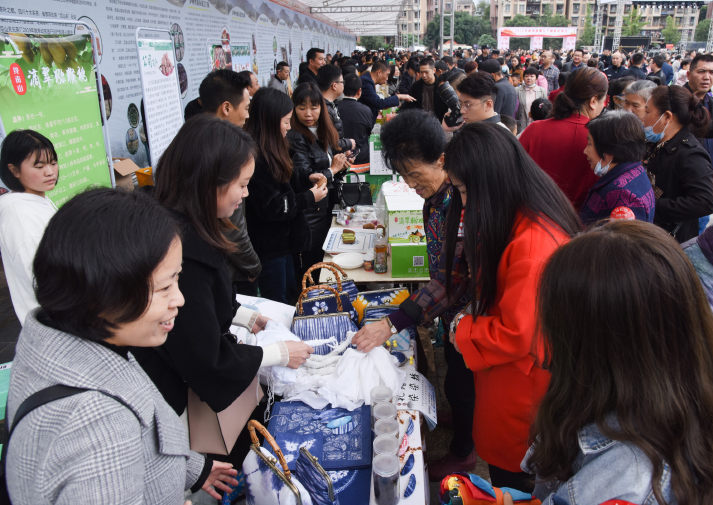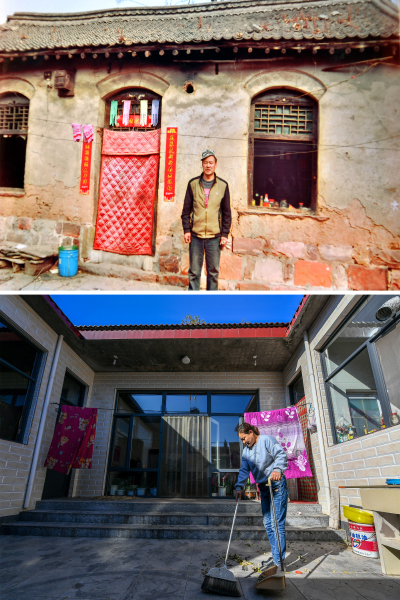| China |
| China's experience may inspire poverty alleviation programs in other parts of the world | |
|
|
 Products from an underdeveloped mountainous region on sale at a poverty alleviation event in Luzhou, Sichuan Province in southwest China, on October 17 (XINHUA)
The novel coronavirus disease (COVID-19) has not only affected the economies of countries and regions but also poses a challenge to the United Nations Sustainable Development Goal (SDG) of ending poverty by 2030. October 17 was a poignant reminder of that. It is the UN International Day for the Eradication of Poverty, which began to be observed 27 years ago. The theme this year was acting together to achieve social and environmental justice for all. The year 2020 is crucial for China, which has to meet the twin goals of building a moderately prosperous society in all respects and eliminating absolute poverty by the end of the year. Though hit by COVID-19, China's poverty alleviation goal is anticipated to be met, which will mean China can achieve the first of the 17 SDGs of the UN 2030 Agenda for Sustainable Development 10 years ahead of schedule. It will also become the first in the world to end absolute poverty, which will have a significant impact on the rest of the world. "I am confident of achieving the goal of poverty eradication this year," President Xi Jinping said during an inspection tour in Ankang in Shaanxi Province, northwest China, in April.  A woman sweeps the courtyard of her renovated house in a village in Zuoquan County, Shanxi Province, north China, on October 16; Her husband poses for a photo in front of their old house (XINHUA)
Targeted policies In the past four decades since reform and opening up began in 1978, China has lifted 850 million people out of poverty. At the end of 2019, the number of the rural poor in China fell to 5.51 million from 98.99 million in 2012. Fabrizio Hochschild Drummond, special adviser to UN Secretary General António Guterres, highlighted China's achievements in poverty reduction in a recent interview, saying, "China's own national success in reducing poverty accounts for a very large part of the global poverty reduction over the past decades. I think there's much that can be learned from what was achieved by China. And I think many other countries are trying to learn." While a vaccine for COVID-19 is still being explored, China has an effective prescription for poverty. Having met over 70 percent of the global poverty alleviation target, it is a credible source of expertise. China's success is based on targeted policies, efficient mobilization of financial and social resources, an advanced environmental protection concept, and the wide use of hi-tech, especially Internet technology. But the biggest factor is the pragmatic leadership. In 2013, Xi visited Shibadong, a remote village in the mountains of Hunan Province, central China, where he proposed targeted poverty alleviation. It meant implementing tailored measures according to different local conditions so that there would be no waste of resources. Locally adapted distinctive targeted poverty reduction measures are likely to be effective for impoverished demographics in other countries as well. China has established an effective mechanism to ensure precision in identifying target groups for poverty alleviation, accurately identify the causes of poverty, set clear targets, tailor measures to specific circumstances, and take concrete actions, particularly in areas with large ethnic minority populations. The projects were carefully planned and officials assigned to carry them out based on local needs. Government officials, teachers, medical workers, academics and entrepreneurs have contributed to the campaign. Over the past three years, more than 200,000 "first secretaries" have been sent to villages to help in the work. Millions of township and village officials are working on poverty alleviation throughout the country. To fund the work, 214 billion yuan ($30.6 billion) additional funds were allocated for impoverished regions between 2018 and 2020. Sustainable growth The poverty reduction campaign is based on environmental protection. Xi said in a development-oriented poverty reduction conference in 2015, "Many impoverished regions now blame their condition on their surroundings. However, looking at it from another perspective, if these regions wish to become prosperous, it is precisely by relying on their natural surroundings that they will do so." The concept that lucid waters and lush mountains are invaluable assets has been promoted. Accordingly, eco-tourism has become a new industry. Shibadong, for example, is promoting eco-tourism with better infrastructure. Last year, the village received more than 600,000 visitors attracted by its improved facilities, landscape as well as the unique Miao culture. The industry has created more jobs. Villagers are operating restaurants and inns, and working as tour guides and shuttle bus drivers. Internet technology has been the silver bullet of the campaign. According to the China Internet Development Report 2020, by the end of 2019, China had 1.31 billion mobile Internet users, more than 94 percent of the population and 32.17 percent of all mobile Internet users in the world. The rapid growth of the Internet has played a significant role in educating and changing mindsets in poverty-stricken areas, harnessing their creativity, and narrowing the information gap between developed and underdeveloped areas. By providing telecommunication and express delivery infrastructure, the government has enabled people in poor areas to hitch their wagons to the express train of e-commerce. By the end of June, 98 percent poor villages had optical fiber network and 96.6 percent townships were covered by express delivery service. All poverty-stricken counties have set up e-commerce service centers. The development of e-commerce has contributed significantly to poverty alleviation. Statistics from the Ministry of Commerce (MOFCOM) show in 2019, online retail sales of products from poverty-stricken counties reached 239.2 billion yuan ($34.3 billion), a year-on-year increase of 33 percent, providing jobs and incomes for 5 million farmers. Internet companies are encouraged to partner with poor regions to promote e-commerce. Data from e-commerce giant Alibaba Group shows that as of June, more than 1.2 million vendors from poverty-stricken counties were selling their products through e-commerce platforms Taobao and Tmall. Live-streaming has become a new effective marketing approach. MOFCOM data show that the first half of this year saw over 400,000 live-streamers promoting more than 20 million items. More and more officials, celebrities and Internet stars are participating in live-streaming marketing campaigns for public welfare. The official standard for being considered out of poverty means an annual per-capita income of 4,000 yuan ($570) in rural areas, with basic food and clothing needs met and education, basic medical care and housing guaranteed. However, it is still not enough for building a moderately prosperous society in all respects, which is the development target during the 13th Five-Year Plan (2016-20). To achieve moderate prosperity, in the remaining months impoverished households will be given loans, skill training and employment support while those unable to work will come under comprehensive social security. Efforts will also continue to make the lives of those who have risen above the poverty line better. (Print Edition Title:Prescription for Poverty Reduction) Copyedited by Sudeshna Sarkar Comments to dingying@bjreview.com |
|
||||||||||||||||||||||||||||
|
